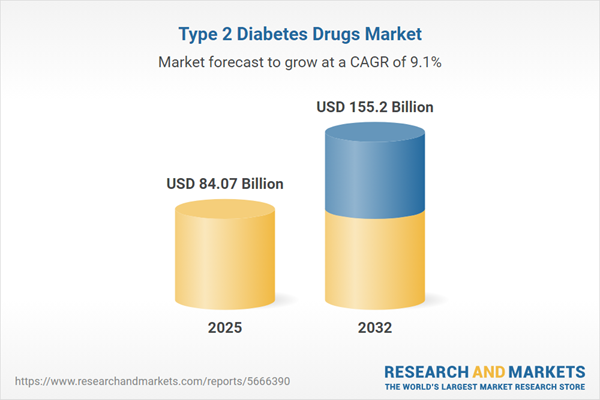Speak directly to the analyst to clarify any post sales queries you may have.
The Type 2 Diabetes Drugs Market continues its robust trajectory, driven by an evolving therapeutic landscape, advancements in patient-centric care, and dynamic regional influences. Strategic decisions in this sector are increasingly influenced by technology integration and shifting global policies.
Market Snapshot: Type 2 Diabetes Drugs Market
The Type 2 Diabetes Drugs Market grew from USD 77.07 billion in 2024 to USD 84.07 billion in 2025. It is expected to maintain momentum with a CAGR of 9.14%, reaching USD 155.20 billion by 2032. Market expansion is propelled by the escalating global burden of Type 2 diabetes and demand for effective, innovative medical solutions.
Scope & Segmentation of the Type 2 Diabetes Drugs Market
- Drug Class: Biguanides (including combination, extended-release, and immediate-release options), DPP-4 inhibitors (alogliptin, linagliptin, saxagliptin, sitagliptin), GLP-1 receptor agonists (dulaglutide, exenatide, liraglutide, semaglutide), insulin (basal, prandial, premixed variants), SGLT2 inhibitors (canagliflozin, dapagliflozin, empagliflozin, ertugliflozin), sulfonylureas (chlorpropamide, glimepiride, glipizide, glyburide), thiazolidinediones (pioglitazone, rosiglitazone).
- Route Of Administration: Injectable (pen, prefilled syringe), oral (capsule, tablet).
- Treatment Line: First line (monotherapy and combination, including dual and triple therapy), second line, third line.
- Distribution Channel: Hospital pharmacy, online pharmacy, retail pharmacy.
- Brand Type: Branded, generic.
- Patient Age Group: 18 to 65, above 65.
- Patient Gender: Female, male.
- Region: Americas (United States, Canada, Mexico, Brazil, Argentina, Chile, Colombia, Peru), Europe, Middle East & Africa (United Kingdom, Germany, France, Russia, Italy, Spain, Netherlands, Sweden, Poland, Switzerland, United Arab Emirates, Saudi Arabia, Qatar, Turkey, Israel, South Africa, Nigeria, Egypt, Kenya), Asia-Pacific (China, India, Japan, Australia, South Korea, Indonesia, Thailand, Malaysia, Singapore, Taiwan).
- Key Companies Profiled: Novo Nordisk A/S, Eli Lilly and Company, Sanofi S.A., Merck & Co., Inc., AstraZeneca PLC, Boehringer Ingelheim International GmbH, Johnson & Johnson, Pfizer Inc., Novartis AG, Daiichi Sankyo Company, Limited.
Key Takeaways for Senior Decision-Makers
- Rapid therapeutic innovation—spanning established and novel drug classes—continues to reshape the competitive landscape, with advanced formulations and mechanisms improving patient adherence and outcomes.
- Digital health technologies, such as wearable sensors and AI-enabled platforms, are quickly becoming standard, enabling data-driven care and real-time treatment adjustments for Type 2 diabetes patients.
- Collaborative ecosystems between pharmaceutical manufacturers and technology providers are accelerating the integration of digital care, telehealth, and behavioral coaching into mainstream treatment models.
- Segmentation by administration route, drug class, and patient demographics enables highly tailored commercial strategies, facilitating more effective resource allocation and go-to-market planning.
- Regional strategies must navigate diverse reimbursement structures and regulatory environments, requiring local partnerships and adaptive pricing models to ensure access and scale.
- Competitive positioning is increasingly defined by investment in R&D, real-world data collection, and market access collaborations across the value chain.
Tariff Impact on Supply Chain and Market Accessibility
- New U.S. tariffs on pharmaceutical imports have compelled companies to reconfigure supply chains, optimize sourcing, and shift production closer to main markets to minimize cost and disruption.
- Drug manufacturers are proactively seeking tariff exemptions and partnering with policymakers to ensure continued access to essential medications in the face of evolving trade policies.
- Emergence of regional production sites and streamlined logistics is strengthening inventory management and safeguarding against regulatory or transportation delays.
Methodology & Data Sources
This report utilizes primary research through expert interviews and stakeholder consultations with healthcare leaders. Secondary research leverages public filings, regulatory data, and reputable industry publications. Data triangulation and scenario planning ensure a comprehensive market view with validated, actionable insights.
Why This Report Matters for the Type 2 Diabetes Drugs Market
- Enables senior decision-makers to benchmark against global and regional trends, supporting agile strategic planning in a complex market.
- Provides a granular analysis of emerging therapies, digital integration, and shifting payer dynamics to inform portfolio prioritization and partnership selection.
- Helps organizations anticipate tariff-related risks and optimize their supply chain and distribution strategies in advance of regulatory shifts.
Conclusion
The Type 2 Diabetes Drugs Market is evolving rapidly, with innovation, digital tools, and proactive regional strategies shaping competitive advantage. Decision-makers equipped with granular insights and future-ready strategies are best positioned to deliver improved patient and business outcomes.
Additional Product Information:
- Purchase of this report includes 1 year online access with quarterly updates.
- This report can be updated on request. Please contact our Customer Experience team using the Ask a Question widget on our website.
Table of Contents
3. Executive Summary
4. Market Overview
7. Cumulative Impact of Artificial Intelligence 2025
List of Figures
Samples

LOADING...
Companies Mentioned
The key companies profiled in this Type 2 Diabetes Drugs market report include:- Novo Nordisk A/S
- Eli Lilly and Company
- Sanofi S.A.
- Merck & Co., Inc.
- AstraZeneca PLC
- Boehringer Ingelheim International GmbH
- Johnson & Johnson
- Pfizer Inc.
- Novartis AG
- Daiichi Sankyo Company, Limited
Table Information
| Report Attribute | Details |
|---|---|
| No. of Pages | 193 |
| Published | October 2025 |
| Forecast Period | 2025 - 2032 |
| Estimated Market Value ( USD | $ 84.07 Billion |
| Forecasted Market Value ( USD | $ 155.2 Billion |
| Compound Annual Growth Rate | 9.1% |
| Regions Covered | Global |
| No. of Companies Mentioned | 11 |









